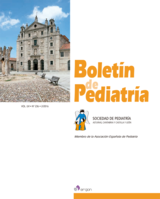Evaluación de la implementación de un protocolo de hipotermia terapéutica en la encefalopatía hipóxico-isquémica neonatal
R.P. Arias Llorente , L. Mantecón Fernández , G. Solís Sánchez , B. Fernández Colomer , E. García López
Bol. Pediatr. 2016; 56 (236): 157 - 166
Introducción. La seguridad de la hipotermia moderada activa (HMA) en la encefalopatía hipóxico-isquémica (EHI) junto con los resultados esperanzadores sobre el pronóstico neurológico ha contribuido a la proliferación de centros donde se oferta esta técnica. Objetivos. Evaluar la experiencia inicial en la implantación de un nuevo programa de HMA: condiciones en las que llegan los neonatos al hospital de referencia, dificultades para llevar a cabo este tratamiento y seguridad de esta intervención. Población. Estudio observacional de una cohorte de pacientes formada por los 15 neonatos nacidos en nuestro hospital o remitidos desde otros centros sanitarios tras presentar una EHI moderada-severa entre el 1 de julio de 2012 y el 1 de enero de 2015. Resultados. El 60% de los neonatos procedía de otros hospitales de la provincia. Todos requirieron una reanimación avanzada (duración: 10-50 minutos). Se registró el inicio de la hipotermia pasiva en el 73,3% de los casos. En el 40% se esperó, al menos, 6 horas para iniciar HMA. Al ingreso en UCIN: 33,3% presentaron temperatura dentro del rango considerado adecuado y 20% temperatura < 33°C, el 80% ventilación mecánica (40% con FiO2 > 40%), 60% hipotensión arterial, 33,3% glucemia < 60 mg/dl. Todos los neonatos tuvieron clínica multisistémica y 53,3% convulsiones. El 35,7% presentaron algún tipo de alteración en su desarrollo neurológico y la mortalidad fue del 6,6%. Conclusiones. El manejo de los neonatos asfícticos es mejorable optimizando la formación del personal que asiste y traslada a estos pacientes. Con el debido entrenamiento, la HMA ha demostrado ser una técnica segura.
Evaluation of the implementation of therapeutic hypothermia protocol in the newborn with hypoxic-ischaemic encephalopathy
Introduction. Therapeutic hypothermia (TH) as the standard therapy in neonates with neurological injury because of hypoxic-ischemic encephalopathy (HIE), provides safe and encouraging results. Because of this, many centers where this technique is offered have multiplied in recent years.
Objective. To evaluate the initial experience in the implementation of a new TH program: clinical conditions of newborns once they arrive at referring hospitals, difficulties to start this treatment and safety of this intervention.
Material and methods. Observational study of a cohort of patients formed by 15 neonates undergoing therapeutic hypothermia due to moderate or severe HIE in our hospital between July 1, 2012 and January 1, 2015.
Results. 60% of the patients came from other hospitals.All of them required advanced resuscitation (from 10 to 50 minutes). The time when passive hypothermia started were recorded in 73.3% of the patients and in 40% were expected at least six hours to start TH. At the admission to neonatal intensive care unit (NICU): only 33.3% of infants were within the target temperature range at arrival and in 20% a temperature lower than 33°C were registered, 80% were in mechanical ventilation (40% with FiO2 > 40%). In 60% of the sample arterial hypothension were recorded and 33,3% of the infants had blood glucose less than 60 mg/dl. The whole sample had multisystemic symptoms and 53,3% had eizures. Had any alteration in their neurological development 35.7% and 6.6% of the neonates died.
Conclusions. The management of neonatal asphyxia can be improved by optimizing the training of the staff who attends these neonates and the transport teams who transfer the newborn to the referral hospitals. With the proper training,TH has proven to be a safe technique.
Artículo completo (PDF) (137 kb.)
- Neonatología
